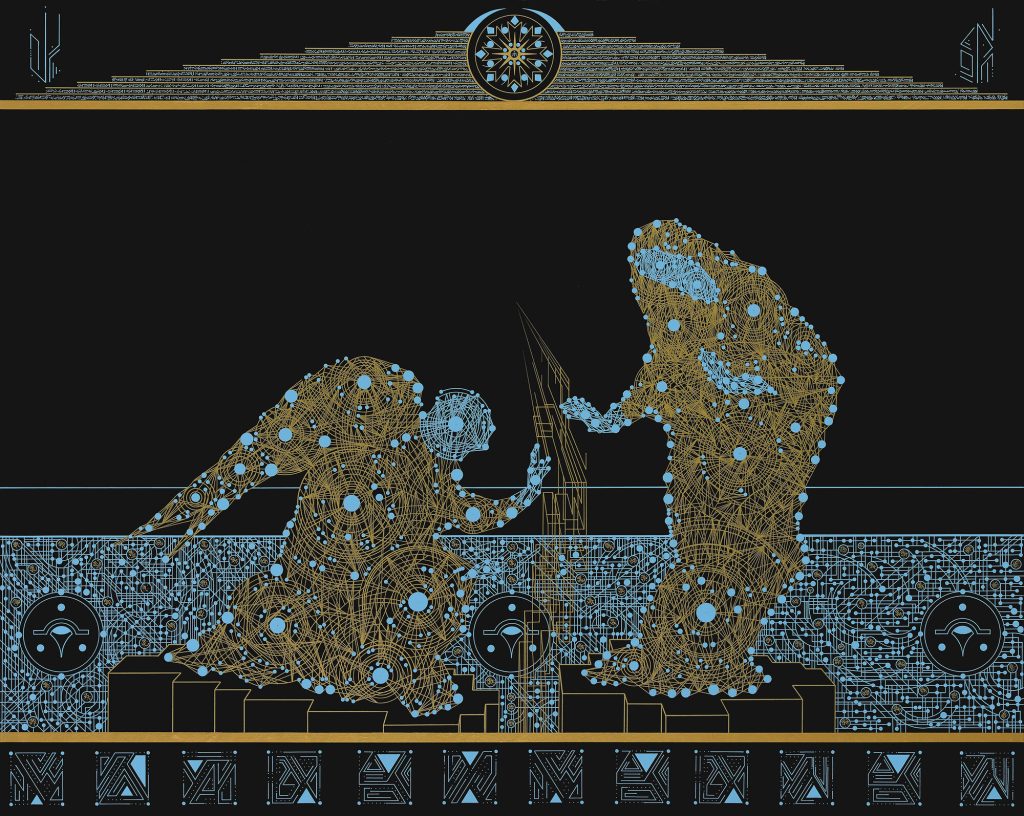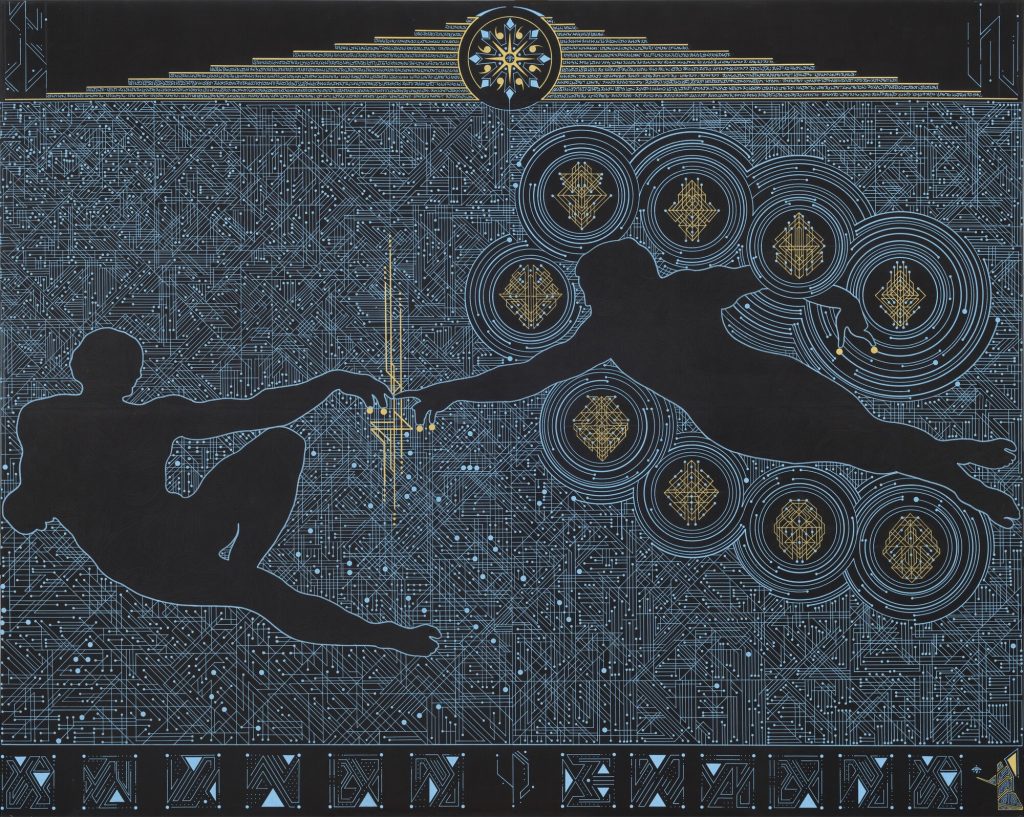


Stepping into Kaikhan Salakhov’s world is like stepping into the future – where art, science fiction, and spirituality collide in unexpected ways. Opening on September 18, 2024, The Cosmic Renaissance marks Salakhov’s most ambitious exhibition to date. Known for his meticulous, hand-drawn geometric patterns, Salakhov uses his background in architecture and philosophy to explore humanity’s cosmic future. His Astral Space Exploration (ASX) Grid is at the core of this exhibition, mapping out the physical and spiritual evolution of civilisations. In The Cosmic Renaissance, Salakhov doesn’t just paint; he offers a vision for a future where technology and consciousness evolve together.
hube: Your work bridges the gap between art, science, and philosophy in a unique way. How does your background in architecture and your studies in various philosophical frameworks influence the development of your Astral Space Exploration model?
Kaikhan Salakhov: The art, science, and philosophy incorporated into my work root the expression in my background in architecture. This background arms me with deep knowledge concerning fractals, which are increasingly central to my interest in organising and systematising complex structures. Being both an artist and an architect, I have always been deeply fascinated by the labyrinthine patterns of fractals and their ability to depict the micro and macro scales of existence. This naturally led to the conception of the Astral Space Exploration (ASX) Model, founded on a systemic and interconnected view of fractals.
I noticed that various philosophical frameworks – AQAL (All Quadrants, All Levels), the Integral Approach, the Wilber-Combs Lattice, and Spiral Dynamics – as well as more science-fiction-based scales, such as the Kardashev Scale, don’t communicate with each other. While these philosophical models offer deep insight into the evolution of consciousness and human development, they mostly operate in isolation from frameworks that describe cosmic advancement, like the Kardashev Scale. The Kardashev Scale traditionally focuses on energy consumption and technological capability without considering internal evolution in consciousness and states of awareness.
This presented an architectural challenge: to harmonise divergent views into coherent, functional structures. What inspired me was the realisation that no comprehensive model exists to integrate both philosophical frameworks of human evolution, like AQAL, and cosmic models like the Kardashev Scale. AQAL and similar models incorporate subjective experience, intersubjective cultural dynamics, and interobjective systemic interactions, while the Kardashev Scale grades civilisations based on energy consumption, remaining limited to the external, physical aspects of reality and ignoring the consciousness and cultural evolution. This one-dimensional theory does not account for the inner developments – values, states, and stages of consciousness – that may drive technological and cosmic ambitions.
The ASX Model takes off from the knowledge that most known frameworks – AQAL, Spiral Dynamics, and the Kardashev Scale, for example – are anthropocentric and species-centric. These models reflect human biases, projecting Earth’s stages of development onto vastly different cosmic contexts. While useful for mapping human growth and societal evolution, they fall short in contemplating a broader spectrum of consciousness and cosmic development that may extend beyond human or Earth-based paradigms.
As I’ve said, this doesn’t diminish their importance; they are probably some of the most crucial models for understanding Earth. If I were an alien tourist, I’d download these maps immediately to grasp humanity. However, beyond Earth, they may not be as useful as they are on this beautiful planet.
Through my work, I aim to transcend these limitations by constructing a model that encompasses diverse forms of consciousness and layers of cosmic development – concepts that challenge and extend beyond human-centred conceptions. The ASX Model is adaptive, especially for future explorations of the cosmos, where forms of sentient life and consciousness that are incomprehensible to the traditional human mind may be encountered. This inclusion is vital because it opens space to consider beings with radically different cognitive architectures, modes of communication, and existential schemas that don’t fit into the linear progressions proposed by other models, such as AQAL and Spiral Dynamics.
AQAL and Spiral Dynamics present hierarchical systems of progression, suggesting a linear development from basic survival instincts to complex integrative levels of awareness. However, in a cosmic context, this may not necessarily be the case. In the universe, there may exist intelligent forms that think non-linearly, interact based on quantum superposition, or use non-verbal communication methods where personal pronouns or words, in general, are irrelevant. These beings may perceive and relate to reality in ways that go beyond human senses. They could act on forms of consciousness that cannot be comprehended by the logic of human developmental stages, making current models insufficient or irrelevant.
Thus, the ASX Model is intentionally dynamic and flexible to accommodate the full range of possible sentient life and its unique developmental pathways. It considers the possibility of xenocultures – alien civilisations whose consciousness and social structures may not only differ from but also challenge human-centred ideas of development. Other considerations within the ASX Model include the internal evolution of Homo sapiens and the potential existence of post-human entities whose cognitive and existential structures could differ from our own. As human evolution continues, even with advanced technologies, genetic changes, or neural enhancements, new forms of consciousness may emerge that challenge, or even obsolete, current human-centred models.
Post-human entities, for example, might experience reality through frequencies, vibrations, colours, and sounds beyond our known range. Their cognitive activity could transcend linear, logical thinking in favour of holistic, multi-dimensional awareness, where information is processed simultaneously rather than sequentially. Enhanced neural structures could allow for direct, non-verbal information exchange – telepathic or empathic communication – leading to group dynamics or quantum hive-mind dynamics that don’t fit into AQAL or Spiral Dynamics.
In acknowledging these possibilities, I aim to make the ASX Model relevant and applicable in a future where distinctions between human, post-human, and alien may blur. The model becomes not just a map of where humanity could head but also an open-ended framework for navigating the unforeseeable or unknowable. The ASX Model attempts to create a scaffold for the unpredictable and unprecedented, recognising that the real nature of the cosmic venture will involve radically expanding our conceptual boundaries. It challenges anthropocentric assumptions and offers a universally inclusive and adaptive paradigm for understanding sentience, intelligence, and development across the cosmos.
h: Astral Space Exploration: The Cosmic Renaissance discusses complex themes such as quantum physics and the multiverse. How do you ensure that these intricate scientific concepts are accessible and meaningful to the viewers of your art?
KS: This exhibit aims to showcase and express a unique array of challenges that humanity will face as we venture into the universe. Through logical reasoning, empirical evidence, and my own exploration of the ASX Grid, I have attempted to present the probable implications of these challenges and how they will impact us all, regardless of our ranking in the universe. The issues I research – such as the point at which the abuses and failures of technologies in quantum communication cause social disintegration, the rise of corporate dominance, the division of humankind into various post-human entities, and, not least, misunderstandings and ineffective communications, diverging paths for post-human groups, and the related interstellar political manoeuvrings and power struggles – are imaginary but plausible scenarios based on our current trajectory.
Each work in this exhibition reflects the multi-faceted perspectives I’ve uncovered within the ASX Grid – an interdisciplinary approach spanning architecture, economics, politics, spirituality, culture, robotics, diplomacy, and more. The goal is to make these complex ideas accessible to humanity in the most attainable way, using visual arts as an international language that transcends barriers, yet encourages viewers to reflect on fundamental questions.
In a piece aptly titled Astral Space Exploration: The Cosmic Renaissance, I distil challenging scientific concepts like quantum physics and the multiverse, which are often highly abstract or intimidating. By abstracting these theories into visual metaphors and patterns, they become more approachable and relatable on an intuitive level. Through geometry, color, and form, I strive to represent not just the content of science, but its vital dynamics, so viewers can grasp the essence without being experts.
My goal is to align these complex theoretical ideas with the viewer’s experience by presenting them with clarity in visual representation, making the invisible tangible and the distant near. I achieve this by blending futuristic motifs with recognisable visual components, using art to stimulate critical inquiry and draw the viewer in, inviting them to consider the complexities and consequences of space exploration.
This is an art that not only imagines potential futures but also engages with the ethical, social, and existential dimensions of our journey into space. My hope is that, through art, I can take grand and intricate ideas about quantum physics and the multiverse and make them not only understandable but personal and emotionally resonant within the ongoing saga of human history.
h: The ASX Grid is a central part of your work, representing the stages of cosmic development. What inspired you to create this model, and how do you see it evolving as humanity progresses toward becoming a multi-planetary species?
KS: The ASX Grid is an attempt by an anthropomorphic life form to think, feel, and act as non-anthropomorphically as possible, avoiding the projection of human-centred logic onto anything in the universe. It is driven by the need to create a comprehensive model that reflects the potential paths humanity might take as we evolve into a multi-planetary species, along with the possible trajectories of other life forms. Existing models like AQAL, the Wilber-Combs Lattice, Spiral Dynamics, and the Kardashev Scale, while insightful in their own right, often impose anthropocentric assumptions on the vast possibilities of the cosmos. They tend to prioritise human developmental stages, cognitive structures, or energy consumption as primary indicators of progress, without accounting for the internal evolution of consciousness or the potential diversity of sentient life across the universe.
The ASX Grid is designed to address the enormous complexities that arise as humanity progresses beyond Earth. As we establish colonies in different planetary environments, each with its own unique challenges and opportunities, we will witness the emergence of distinct planetary and stellar identities – a concept I call *Cosmogeopolism*. Cosmogeopolism posits that each star system and planetary environment uniquely shapes the development of various forms of post-humans, which, over time, will diverge from their human origins. These post-humans will differ not only in their biological makeup – due to genetic engineering, cybernetic enhancements, or other adaptations – but also philosophically, culturally, and societally.
Each colony will form its own identity, value system, and governance, all of which will reflect the specific pressures and potentials of their particular environments. The ASX Grid anticipates these changes, using an adaptive framework that accounts for both outer technological revolutions and inner evolutions in consciousness. It foresees that as humanity branches out, posthuman forms will differ greatly in their modes of existence and culture. This encompasses how they perceive reality, interact with their environments, and construct the philosophical foundations of their societies. The ASX Grid accommodates non-linear and multi-dimensional growth paths, each unique and reflective of their respective planetary conditions.
As these divergent evolutionary paths unfold, distinct planetary and stellar identities will emerge, shaping the future of humanity. These differences will influence cosmogeopolitical stances, interstellar relations, governance, and alliances. Each colony’s conditions and historical experiences will give rise to a mosaic of cultures and societal norms, as varied as the star systems they inhabit. This divergence will not be limited to technological or biological adaptation but will also transform how these colonies understand themselves, their place in space and time, and their relationships with one another.
The ASX Grid is intended to evolve alongside humanity as we embark on our journey of cosmic expansion. It offers a cartography that interrelates the various forms of posthuman evolution in complex ways, revealing how different planetary conditions give rise to new modes of consciousness, cultural expressions, and societal organisations. This framework is inherently open and comprehensive, providing a means to engage fully with the multiple dimensions of human and posthuman experience that will define our multi-planetary futures.
Furthermore, the ASX Grid is designed to accommodate alien life forms with cognitive architectures and communication methods that are utterly beyond anything we can currently imagine – whether it be nonlinear quantum thinking, non-verbal interactions, or unfamiliar sensory inputs. The ASX Grid will continue to evolve as humanity journeys into the stars, gaining new insights and developing in tandem with our expansion. It will chart not only our technological progress but also serve as a guide through the profound changes in identity, culture, and consciousness that accompany cosmic exploration. This process will take humanity through the full spectrum of our potential – biologically, culturally, and philosophically – as we settle and explore the cosmos.

